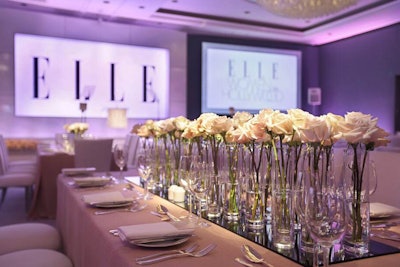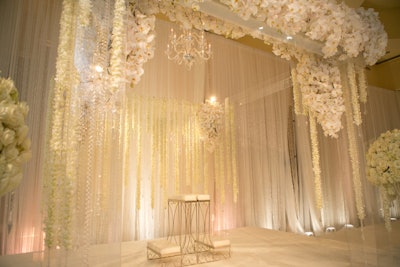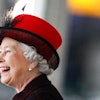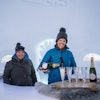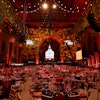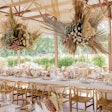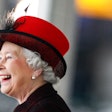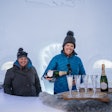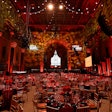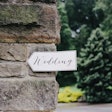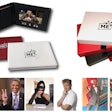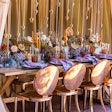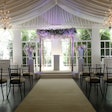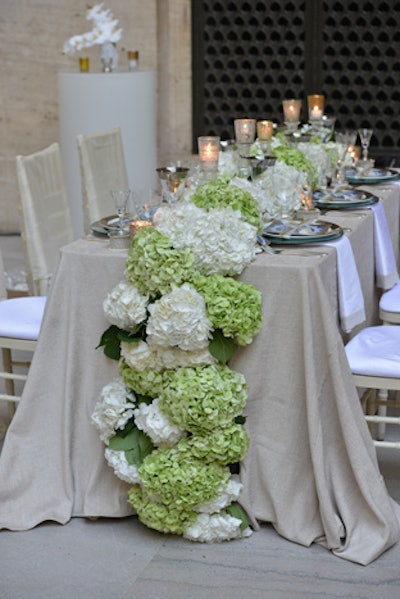

With a smartphone in nearly every guest’s purse or pocket, wedding-day photos are almost guaranteed to appear in real time on social media sites. But more and more couples are politely restricting smartphone usage during the ceremony using cleverly worded signage (displayed at the venue’s entrance or printed in the ceremony program), as well as verbal reminders from the officiant.
“We’re going to see more and more ‘unplugged’ ceremonies in 2014,” says Renny Pedersen, owner of the Chicago-based wedding planning company Bliss Weddings & Events. “Nothing is worse than seeing a beautiful photograph of the bride walking down the aisle marred by a bunch of cameras and iPhones. This way, the wedding photographer is able to get the most important shots, without any unobstructed views.” Bonus: Guests will also be more present during the ceremony.
Pictured: A printed chalkboard sign by DesignSmithPaperArts asked guests to keep their smartphones and cameras in check.

Photo booths are practically de rigueur at receptions. But for couples who want something new: Enter the slow-motion video booth. It’s the same idea—guests take turns posing with props like confetti and neon sunglasses. But the station is set up with a video camera; after the wedding, the footage is edited into a slo-mo mini movie trailer and set to a catchy pop tune.
“The result is a keepsake video that captures the fun of the wedding day in a totally different way than stills,” says Rebecca Grinnals of wedding industry consulting firm Engaging Concepts.
Pictured: Production company Super Frog Saves Tokyo creates slo-mo booths.

After an abundance of rustic-barnyard and vintage, Anthropologie-esque weddings, event planners are anticipating a wedding-style movement in the complete opposite direction. “We’re predicting less D.I.Y. and more clean, modern lines and color palettes,” says Tara Maxey, co-owner of the Los Angeles-based catering company Heirloom LA. “With all the D.I.Y. wedding details out there, expertly styled minimalism feels like the sophisticated alternative.”
Wedding planners Maria Cooke and Kelly Seizert of Ritzy Bee Events in Washington, D.C., agree: “We’re seeing more couples focusing less on dramatic color and more on classic combinations such as black and white, gray and white, and navy and cream.” The modern-minimalist theme will be reflected in the wedding menu, too: Instead of lavish buffet stations or decadent entrées, couples are moving towards healthier choices and smaller portions. Maxey says, “Gluttony has been overdone.”
Pictured, clockwise from left: Ritzy Bee Events created a reception lounge setup with a clean, neutral color palette; a wedding catered by Heirloom LA incorporated crisp, all-white decor; shooters of vegan carrot panna cotta were served during cocktail hour at a wedding catered by Heirloom LA.

In contrast to the modern-minimalist style, wedding professionals are also predicting a return to formality and dramatic opulence. “Say goodbye to Mason jars and burlap, and say hello to caviar and elegance,” says South Florida-based party planner Sara Renee Lowell of Sara Renee Events. “Wedding vendors are sick of couples bringing in the same rustic, vintage inspiration photos. Opulence is in.”
Which means the return of dramatic floral arrangements on pedestals, gleaming candelabras, and loads of professional lighting (translation: no more simple strands of café lights). For a recent wedding, New York event designer David Stark of David Stark Design and Production created a luxurious reception with a formal French garden theme: Sculpted hedges around the perimeter of the venue and structured dinner table centerpieces were juxtaposed against a lush, romantic canopy of flowers and glowing lanterns suspended overhead.
Pictured: David Stark created a formal French garden theme for a recent wedding reception.
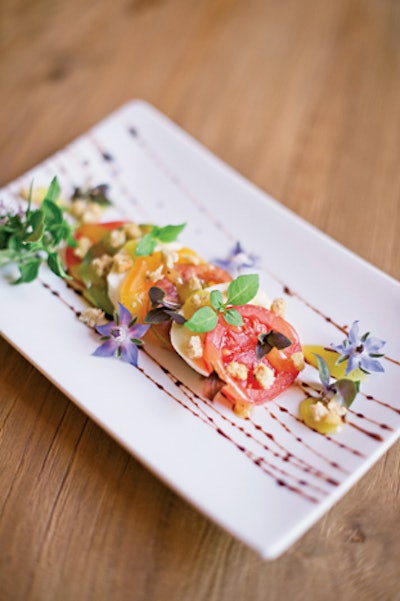
Family-style dinners were a huge trend last year, but they’re actually quite expensive to pull off, and the platters of food require significant table real estate, says Calder Clark of South Carolina-based Calder Clark Designs. So, what’s next? Bar-height tasting stations, where guests receive artfully plated, fork-friendly miniature meals prepared on the spot by stationside chefs. Experts say guests love the variety.
“Today’s couples are serious foodies, and they come bearing recipes and resolute memories from their favorite restaurants,” Clark says. “They want to include them in the reception, and there’s no easier way to do that than with the tasting plate—it’s petite, going back for seconds is totally kosher, and guests are able to be more experimental with unfamiliar foods.”
Pictured: For a wedding designed by Calder Clark, chef Johannes Klapdohr created an elegant tasting plate of Southern fried tomatoes drizzled with aged balsamic vinegar and accented with edible nasturtiums.

More couples are opting for unique and casual styles of hand lettering. “Classic calligraphy will continue to be a mainstay, but I think we’ll see hand lettering continue to grow in popularity in 2014,” says Nole Garey, founder and editor of the stationery blog Oh So Beautiful Paper. “It’s whimsical and pretty but also slightly more approachable.”
Like formal calligraphy, each hand-lettered invitation is a custom design, which lets couples create something that conveys their personalities and gives guests a sneak peek at the celebration to come. “Hand lettering is also a wonderful option for a couple that wants something more personal than a font but prefers something more edgy than calligraphy,” Garey says.
Pictured: Ladyfingers Letterpress creates hand-lettered invitations.

Rather than decorating the reception with a slew of blink-and-you’ll-miss-’em D.I.Y. details, couples are more interested in decor that makes a statement. “The 2014 bride is ditching contrivances for oversize ‘wow’ factors like custom dance floors, vast patterned wall installations, and Versailles-worthy furnishings and lighting,” says Clark. “Our client is tired of littering seated tables with tchotchkes and is favoring the mantra ‘go big or go home’—in good taste, of course.”
As a result, couples are asking, “What will catch my guests’ attention when they walk in our tent?” Clark says. “Savvy couples realize that very few will remember custom-colored confetti packets at each place setting, but everyone will remember a nighttime ceremony lit only by 500 luminaries.”
Pictured: For recent wedding, Calder Clark designed an installation that served as a focal point: The 3-D wall was inlaid with boxwood topiaries arranged in a geometric pattern.
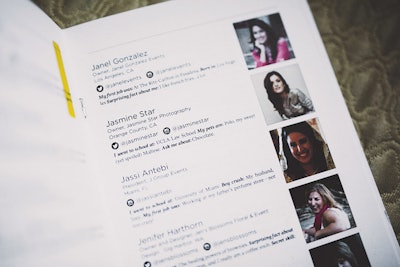
It’s every wedding guest’s worst nightmare: sitting next to complete strangers at an assigned reception table. Guesterly, a new publishing company helmed by a former editor at Oprah’s O magazine, aims to alleviate that anxiety by helping guests connect in a fun, unforced way. Through the service, couples can create a custom magazine-style “yearbook” filled with photos and fun facts about guests, along with how they know the bride or groom. Then, the mini magazines are mailed to guests before the wedding or distributed at the ceremony. “It helps breaks the ice and allows for meaningful interaction among guests,” Grinnals says.
Pictured: At the Engage!13 wedding conference in Scottsdale, Arizona, guests were given a custom booklet by Guesterly containing photos and brief bios of each attendee.

